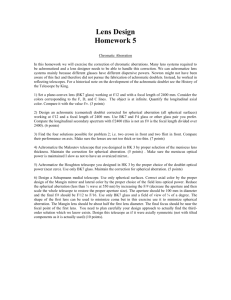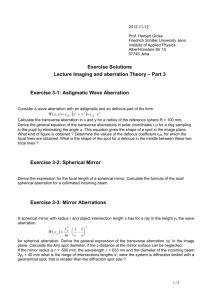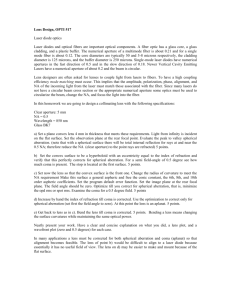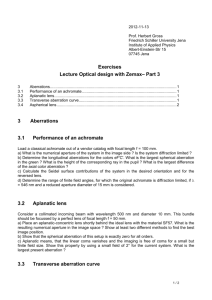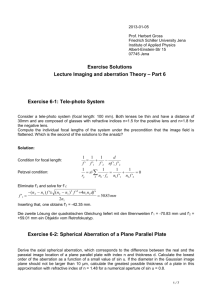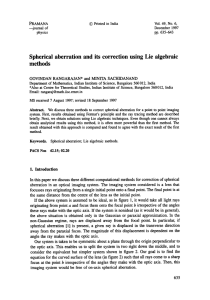IAT13_Imaging and Aberration Theory Solutions WS 13
advertisement
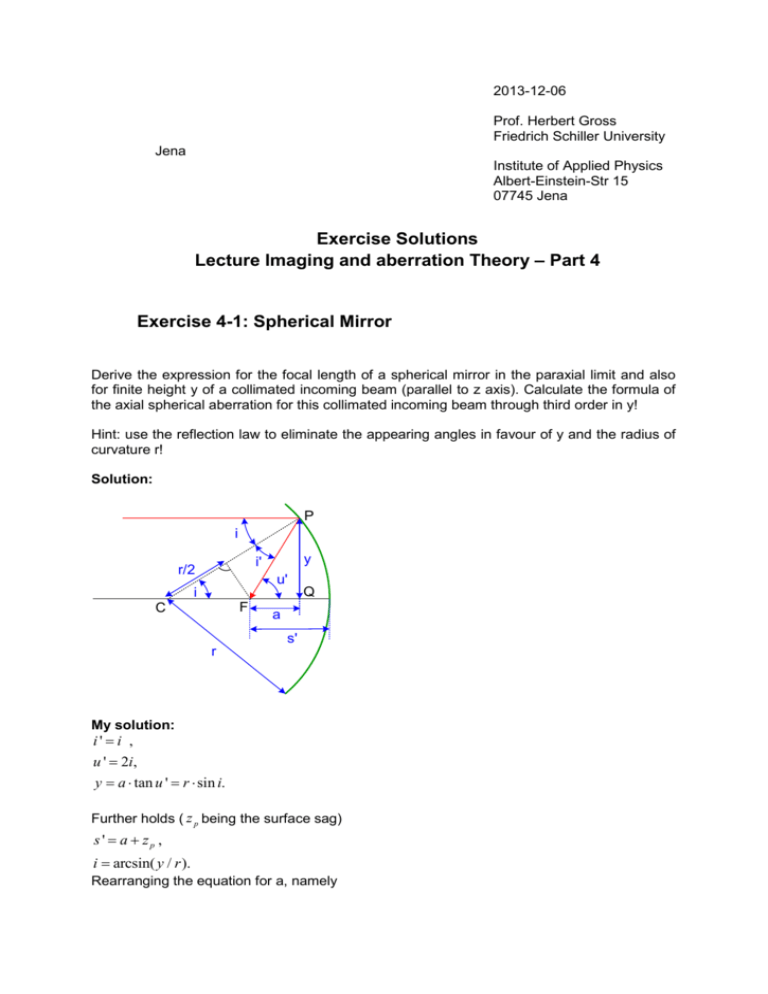
2013-12-06 Prof. Herbert Gross Friedrich Schiller University Jena Institute of Applied Physics Albert-Einstein-Str 15 07745 Jena Exercise Solutions Lecture Imaging and aberration Theory – Part 4 Exercise 4-1: Spherical Mirror Derive the expression for the focal length of a spherical mirror in the paraxial limit and also for finite height y of a collimated incoming beam (parallel to z axis). Calculate the formula of the axial spherical aberration for this collimated incoming beam through third order in y! Hint: use the reflection law to eliminate the appearing angles in favour of y and the radius of curvature r! Solution: P i y i' r/2 u' i F C Q a s' r My solution: i' i , u ' 2i, y a tan u ' r sin i. Further holds ( z p being the surface sag) s ' a zp , i arcsin( y / r ). Rearranging the equation for a, namely a r sin i y r 2 2 y2 tan u ' tan(2*arcsin( y / r )) 2 r 2 y 2 Adding the surface sag z p r r 2 y2 and subtracting that from the paraxial focal distance r/2, we get 1 r s ' r / 2 r 1 2 r 2 y2 y2 O y3 . 4r Another solution by Prof. Gross: According to the figure, we have the relations i ' i , u ' 2i y a tan u ' r sin i in paraxial approximation we have a tan u a tan 2i a sin 2i 2a sin i r sin i 2a sin i r sin i f s' a zP r / 2 r r 2 y 2 r 2 With the geometric relations sin i y r/2 , cos i r r s' we get sin 2 i cos 2 i 1 y2 r2 / 4 1 r 2 (r s ' ) 2 r s' r 2 1 ( y / r )2 The spherical aberration is given by r 1 s' s'r / 2 1 2 1 ( y / r )2 In 3rd order the spherical aberrations is given by the easy expression r 1 y2 s' 1 2 1 0.5 y 2 / r 2 4r Exercise 4-2: Spherical Aberration of a single lens A thin plane-convex lens with focal length f' = 100 mm is used to focus a collimated beam with diameter D = 10 mm and wavelength = 1.06 m. Draw a sketch of the lens in the optimal setup and explain why this orientation is advantageous! Calculate the magnification parameter M and the bending parameter X of the lens. The Quantity M is defined to be M : and X : uu' , u u' r2 r1 , r2 r1 where u and u’ are the angles of the ray with respect to the optical axis. The surface contribution of the primary spherical wave aberration of a single lens can be expressed by the formula 2 3 2 2 n2 1 1 n n2 n n 1 2 As X M M 32n( n 1) f 3 n 1 n 1 n2 n2 Calculate this coefficient for the refractive indices n = 1.4 and n = 2.0! Which choice of refractive index is more advantageous? Also, calculate the transverse aberration y’ in the image plane in the one-dimensional case with the pupil coordinate yp by using this formula in the form WSPH y p As y 4p for both indices. Compare the geometrical spot size and the diffraction Airy diameter! Is the system diffraction limited? Solution: Sketch of the setup: D f' In this orientation, the bending of the rays is distributed on two surfaces. This gives smaller incidence angles and a smaller impact of the non-linearity of the law of refraction, which generates aberrations. The bending parameter is: the magnification parameter is: X = +1 (-1 in Kingslake!!!) M = +1 By inserting the data for f, n, X and M we get the coefficients: 1. index n = 1.4 : As = -4.598 10-7 mm-3 2. index n = 2.0 : As = -1.25 10-7 mm-3 The transverse aberration is related by with the wave aberration by y' R W f '4 y 3p As yp with reference sphere radius R = f'. This gives for the two cases the geometrical spot sizes n = 1.4 DGeo 2y' 46m n = 2.0 DGeo 2y' 12.5m The Airy diameter is given by DAiry 1.22 2.44 f ' 25.9m sin u ' in Therefore, in the case of the higher index n=2, the system is diffraction limited, the smaller index delivers a geometrical dominated broadening of the spot size. Exercise 4-3: Thin Lens Formula for Spherical Aberration The equation for the contribution of the spherical aberration of third order of a single dielectric surface reads n' (n'n) 1 1 n' n' n AS 8n 2 s' R s' R 2 Use this formula to derive the corresponding formula for a single thin lens from Exercise 4-2: ( lens) S A 2 n3 n 2 (n 1) 1 n2 2(n 2 1) 2 X M M 32n(n 1) f '3 n 1 n 1 n2 n2 (Hint: elimination with the help of imaging and lens maker equation) Solution: From the expressions of the formula for the front surface ( lens) S1 A n(n 1) 1 1 8 R1 s '1 2 n n 1 R s ' 1 1 and the rear surface 2 ( lens ) S2 A (n 1) 1 1 1 n 1 , 2 8n R2 s2 ' R2 s2 ' we get with the magnification parameter 2f 2f 1 1 s s' 1 M 1 1 M 1 , s 2f s' 2f M the lens bending X R2 R1 R2 R1 and the focal length of the lens 1 1 1 (n 1) f R2 R1 and the lens makers formula for the first surface 1 1 n 1 s '1 ns nR1 and s2' = s' and s 2f M 1 Expression of the radii by f and X 1 X 1 1 X 1 , R1 2(n 1) f R2 2(n 1) f Now R1, R2, s, s', s'1 are eliminated by f, X and M. This gives the formula as desired. Exercise 3-5: Field flattening lens Calculate a thick meniscus shaped lens with refractive index n = 1.5 with vanishing Petzval curvature contribution, a focal length of f = 100 mm and a front radius of r1 = +10 mm. The back radius and the thickness are to be determined. Solution: The Petzval sum reads n' n 1 j j rp j n j n' j rj The condition of a vanishing Petzval curvature is given by 15 . r1 15 . r2 0 15 . 1 1 15 . From this equation we get, together with r1 = 10 mm, the radius r2 = 10 mm. In the case of a thick lens we have the focal length f ' nr1r2 n 1 nr2 r1 n 1d If this equation is resolved for d we get the thickness d n( r2 r1 ) rr rr 1 2n 1 2n 6 mm 2 n 1 ( n 1) f ' ( n 1)2 f '


